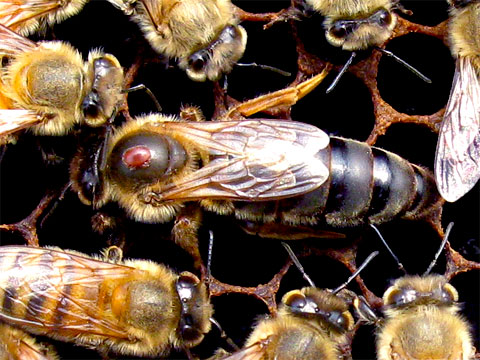 |
| Varroa Mite on a queen bee |
 |
| Worldwide spread of the Varroa Mite |
There are many methods of treating your hives for mites such as the pesticides Apistan and Checkmite. As with all pesticides, the pests may adapt and therefore it is suggested that treatments be changed each year to prevent adaptation. Traces of the chemicals may remain and accumulate in the wax. This can weaken the bees immune system and makes them more susceptible to pathogens and pests.
There are also a number of organic mite treatments like drone brood removal, brood breaks (through natural splits), heating (see below), screened bottom boards, Formic (Mite Away Quick Strips) or Oxalic acid (Powerpoint by Randy Oliver), mineral oils (including thymol as crystals or Apiguard) and sugar dusting (Study by Randy Oliver). It is suggested that you use a combination of control measures.
While there are many proposed forms of bio control of Varroa (i.e. Metarhizium anisopliae, Beauveria bassiana ...) the predatory mites used to control Varroa are a species of Stratiolaelaps mites (Hypoaspis) which have been used for biological control in horticulture for over 15 years (Stratiolaelaps). This predator mite attacks the phoretic (adult) stages of the Varroa mite. The idea is that they can keep the Varroa population at a low level which does not significantly effect the colony. Unlike some chemicals Stratiolaelaps (Stratiolaelaps) can be used throughout the year (during the nectar season), there is no accumulation in the hive wax and presumably no adaptation by the Varroa.
The results from the early stages of testing of the use of Stratiolaelaps have been mixed. The "Niagara Beeway" in southern Ontario have reported positive results.
Varroa Mite Final from Electric Dreams Video on Vimeo.
As part of the Bee Informed survey Brookfield Farm in northwest Washington State found Strateolaelaps did not reduce the population of Varroa in the bee colonies. Here is a post by Brookfield Farm detailing the methods and results of predatory mite usage (Mites that might eat mites). The issues regarding the use of Stratiolaelaps are that they only works on adult bees (not the larvae where mite reproduction take place), do not work on heavily infested hives, are expensive and they leave the hive for their natural environment in the soil. An updated video from the Niagara Beeway contradicts some of these findings suggesting that there were no mites in the drone brood and Stratiolaelaps were breeding in the hive. I've not seen any studies since to support this. They also suggest that they may provide a solution for the small hive beetle. In the video Ham SS refers to Stratiolaelaps.
Phil Chandler, the "Barefoot Beekeeper" proposes the use of an "Eco Floor" in a Top Bar Hive in this case to provide a natural environment for predatory mites. The Eco Floor can be adapted to any style of hive.
"A simple modification to the floor of the horizontal (Kenyan-style) top bar hive improves insulation, reduces air exchange at floor level and creates an enclosed ecosystem designed to provide habitat for earwigs, wood lice, moulds, fungi and myriad other flora and fauna that may be found inside the average hollow log - the natural habitat of the honeybee."
"No creature on Earth lives in isolation from all others. All sorts of relationships develop between different species, many of them mutually beneficial. Yet honeybees are usually housed in sterile, wooden boxes with little opportunity to come into contact with the myriad other bugs, beetles and bacteria found in their natural habitat: hollow trees. Little is known about the effects on bees of other organisms, but it seems reasonable to suppose that because they have co-evolved with a whole range of other species over tens of millions of years, they will have developed mutually beneficial relationships with some of them." Phil Chandler
In this video Phil Chandler shows how the deep floor is made and how it can be retro-fitted to any top bar hive.
As of yet Phil has not done any studies on long term resident population of Strateolaelaps in the hive (Eco Floor). The problems with the "Eco Floor" are the hive is generally warmer than the natural environment of Strateolaelaps (soil), there is no light in the hive to allow for plant growth (part of Strateolaelaps diet) and there is no evidence that Strateolaelaps will leave the soil and travel upwards through the frames to feed on Varroa.
In New Zealand there are preliminary studies being carried out on the use of Pseudoscorpions as predators of Varroa (Pseudoscorpion Study). There are also preliminry studies from the University of Warwick (England) (Varroa killing Fungi) on naturally occurring fungi that kill the varroa mite. They have narrowed the field down to four potential lethal fungi and are determining the method of delivery (i.e. foot bath, spray..). In addition mycological researcher Paul Stamets has found that mushrooms offer many benefits to bees including detoxification, immunity booster and disease control, and increased longevity of worker bees. It has been suggested by some that this is due to the natural presence of oxalic acid which is relatively low (Oxalic acid presence in mushrooms).
 | |
| These graphs show the effects of mycelium fungi increasing bee survival rate and longevity |
In Germany they are studying the use of mite sex pheremone to disrupt male sex activity and have found a significant reduction in mite reproduction.
For many years researchers have been studying the effects of heat on Varroa. At temperatures above 39 celsius (102 fahrenheit) mites suffer irreparable damage while bees can manage temeratures up to 45 celsius (113 fahrenheit).
There have been many marketed hive heaters from the inexpensive Mite Zapper , to the under hive mounted Hive Sauna to the Thermosolar Hive above ($650 U.S. plus shipping). To enable exacting heat control so as not to harm the bees expensive sophistication appears paramount. There is also the issue of honey deterioration at high temperatures. Heating honey to 37 celsius (98 fahrenheit) reduces nutritional value.
On a unrelated note a BYU undergraduate is working on a biocontrol of American Foulbrood. Phages (microscopic bugs) are used to kill the AFB bacteria.
“Phages are the most abundant life form on the planet and each phage has a unique bacteria that it will attack,” said Sandra Burnett, BYU professor of microbiology and molecular biology. “This makes phage an ideal treatment for bacterial disease because it can target specific bacteria while leaving all other cells alone.”
The trick is identifying the right phage. They have narrowed it down to 5 phages (Research article).
I believe the future of dealing with Varroa will be breeding for Varroa Sensitive Hygienic behavior (Breeding for Hygienic Behavior by Marla Spivak and Gary Reuter). Many believe that the VSH behavior traits are passed both genetically and through observed learning. In hives with VSH behavior bees, bee pupae infected with mites are detected and removed. Other VSH behavior traits include: more effective self grooming; group grooming; guard bees removing mites from bees entering the hive (either killing the mites or chasing them from the hive) and bees using their mandibles to kill the mites. Decreased drone production (most mite reproduction takes place in drone brood) and a higher resistance to diseases (the diseases passed by the mites kill the bees not the mites themselves) are also desirable breeding traits. While there are very positive results of breeding queens for VSH behavior the long term problem is the inability to flood the area breeding population (drones as well) with bees possessing VSH traits. It is important to remember that Asian honey bees (Apis cerana), African honey bees (Apis mellifera scutellata), Africanized honey bees (hybrid European and African) and a strain of Russian honey bees have developed an effective resistance to the varroa mite. Some believe that the unnaturally increased size of Apis Mellifera (carried out 100 years ago to increase honey production) hinders their attempts to remove the mites and the enlarged areas between body segments allows for mite penetration. If true this would support the beliefs of natural, small-cell beekeepers who also support the practice of non treatment. To this point there is no scientific, conclusive proof of this theory (some natural beekeepers would argue this). The video below shows bees displaying VSH behavior by removing mites (removal at the 2 minute point of the video).
For further information on hygienic behavior in honey bees go to the Hygienic Behavior section of our Beekeepers' Library.
While I don't profess to know the perfect solution this year I am using Mite Away Quick Strips (naturally occurring formic acid) to control the Varroa population. I'm treating usuallly at least twice per season based on what has worked for me (once in early summer May-June and once in late summer, September). This method is open to change as needed or not. I test regularly but not so much to derive a specific number but to compare the health of the colony with the mite population to observe any possible developing coping mechanisms. For more information on Varroa Mites and mite treatment go to the Varroa Mite section of our Beekeepers' Library. I hope that whatever method of mite defense you employ is successful and that you and your bees are healthy and happy.
"There is no other field of animal husbandry like beekeeping. It has the appeal to the scientist, the nature lover, and even (or especially) the philosopher. It is a chance to work with some of the most fascinating of God's creatures, to spend time and do work in the great outdoors, to challenge my abilities and continue to learn. My hope is that I never become so frail with old age that I cannot spend my days among the bees. It gives credence to the old saw that "the best things in life are free". I thank God daily for the opportunity and privilege to be a beekeeper."
hi all
ReplyDeletethis is a video about pseudoscorpions which occur naturally in normal hives. i have made my own video in coquitlam with scorpions i found in hay in a barn. the critters did eat the mites. as soon as you "treat" a hive, the scorpions leave or are killed. i can be reached at hammer.mann at hotmail dot com. no commercial/financial interests, just want to spread the word about natural beekeeping. got 5 treatment free/smoke free hives going atm.
for the bees, r. cheers
https://www.youtube.com/watch?v=y1zdancXRDg
Good video. Seems they like to play with their food. If the scorpions leave the hive as expected similar to Strateolaelaps it seems to me you have the same problems. First they can't access the majority of mites which are in the brood and second they leave to their natural environment in the soil. Possibly a hive eco floor would provide a suitable home but though it's been suggested to me by Phil Chandler as of yet he has no proof of it's acceptance. I'm a fan of natural beekeeping but there are different levels of "natural". If you suggested this to the queen of "natural" beekeeping Dee Lusby she would pull out her shot gun. Are you natural or natural treatment free (i.e. nein scorpions - the website is in German)? Bee well.
ReplyDelete